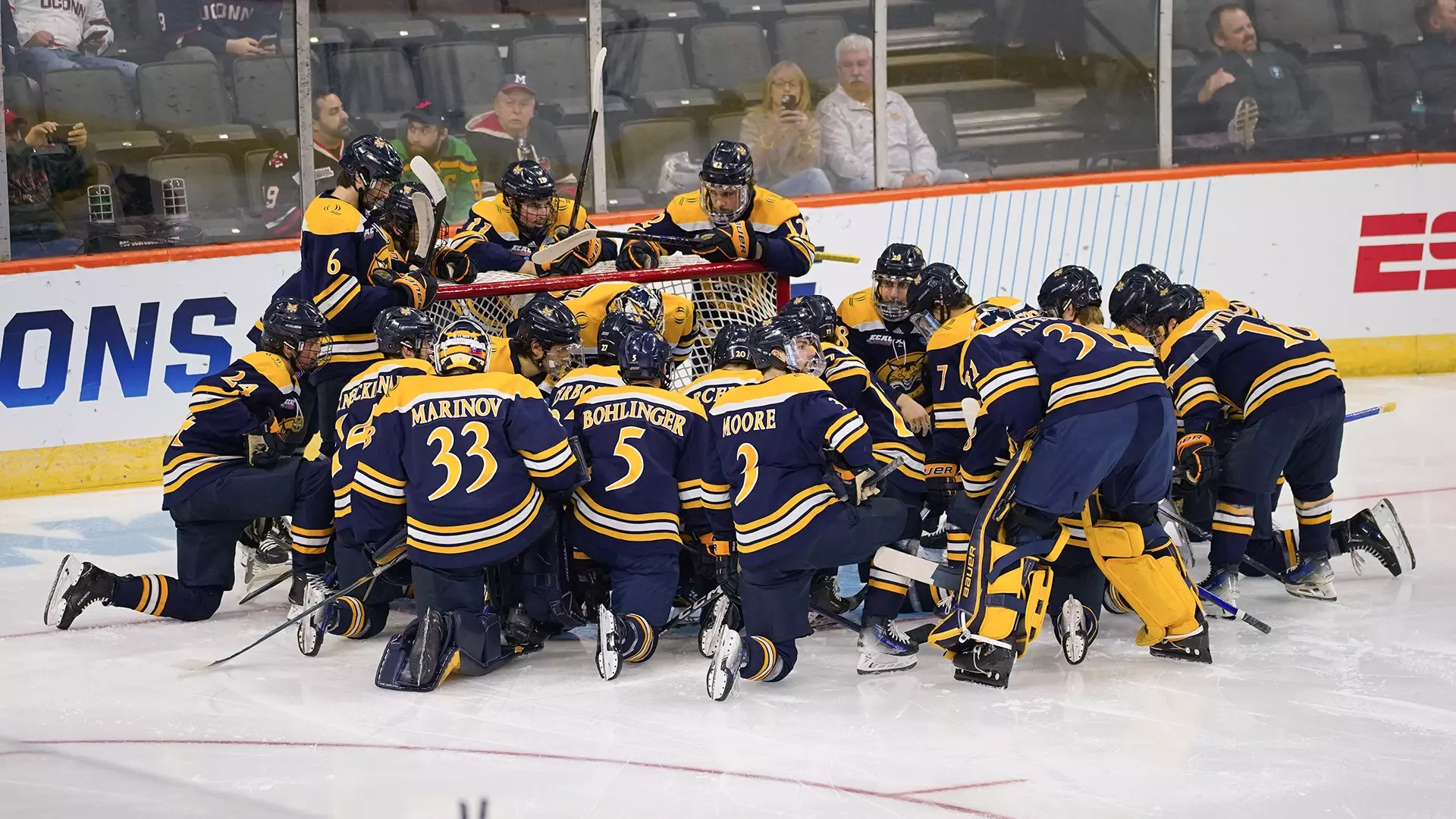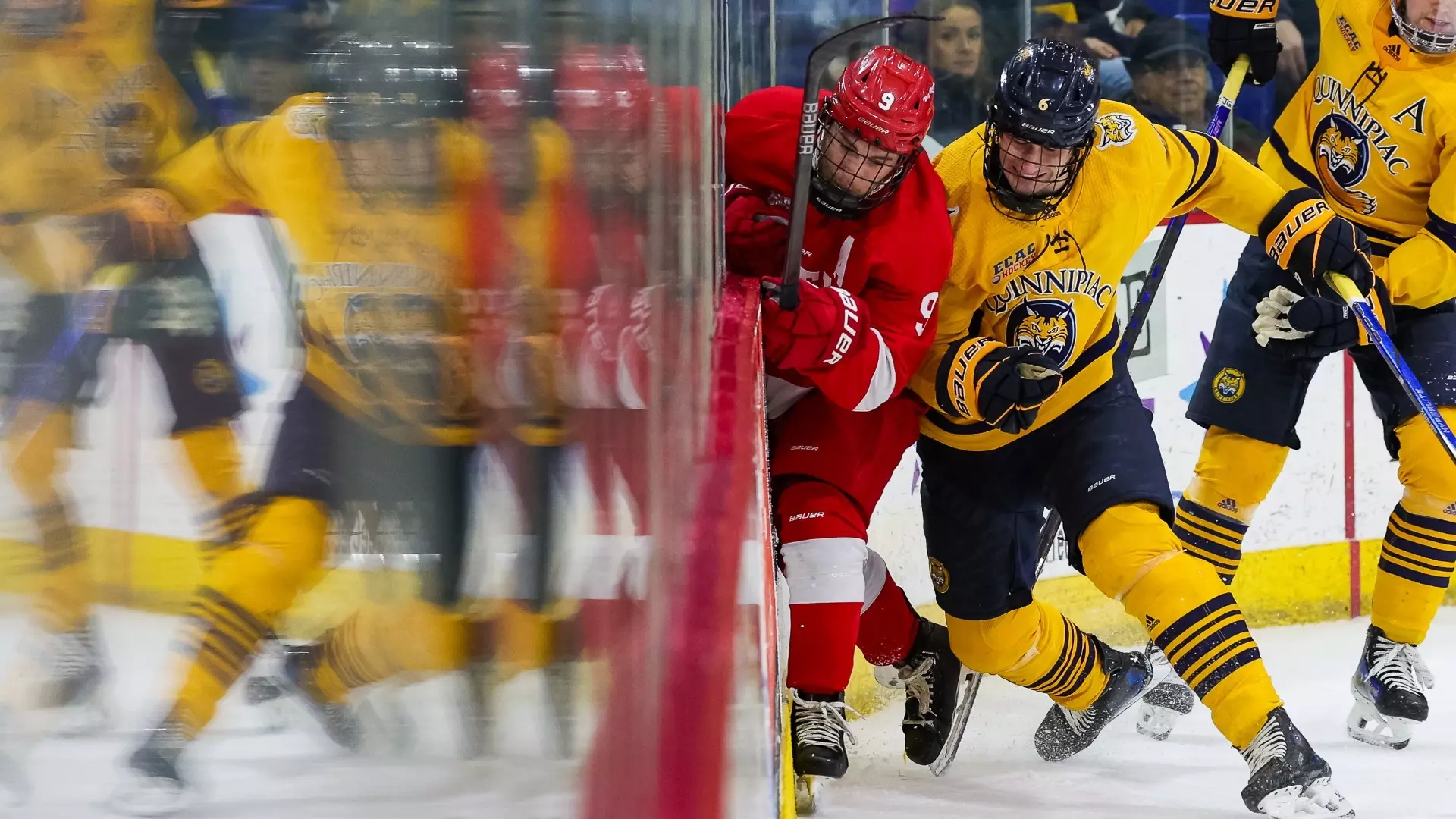By Connor Coar and Zachary Carter
Quinnipiac’s net remained empty. The faceoff was set to be taken in UConn’s defensive end with just over two minutes to play in the third period. Off the draw, skipping up the boards and bouncing off the shoulder of Quinnipiac forward Mason Marcellus, the puck landed on the stick of UConn’s Joey Muldowney. The sophomore flung the puck the length of the ice, watching as it started left, popped up on its side before finally veering right and into the back of Quinnipiac’s unmanned net.
Ballgame.
The goal – UConn’s fourth of the game – cemented the Huskies’ win in the Allentown regional opening round, sending Quinnipiac home in unceremonious fashion. UConn dominated all game, unlike their previous matchup with Quinnipiac in the Connecticut Ice semifinal round, which was decided with less than a second to play in regulation.
UConn scored two early goals and took the match 4-1, never giving Quinnipiac a chance to climb back in. The Huskies will move on to the regional final against Penn State on Sunday, while the Bobcats will pack their bags and load the bus due northeast for Hamden, where Quinnipiac will regroup and plan for next year. Let’s open the notebook and see where Quinnipiac went wrong in contrast to what went right for UConn.
What went wrong: Quinnipiac
Effort. It’s cliche, but Quinnipiac did not play a full 60 minutes. Head coach Rand Pecknold admitted his team was flat early, but fought to the end in an attempt to overcome a sluggish start. The Bobcats have advanced to the regional final every year since 2021 and were determined to do so again. UConn’s relentlessness got in the way of that streak.
Pecknold: “We just didn’t have enough. It took us too long to get us going. So that’s disappointing.”
Luck. Quinnipiac never led throughout the course of the game, but it occasionally threatened a comeback — one that ultimately failed to arrive. The Bobcats’ best chance came in the third period. Though they trailed by two, the offense had started to click, as 11 of Quinnipiac’s 22 total shots came in the final frame. With the puck on the blue line, defenseman Elliot Groenewold fired a shot that beat UConn goaltender Callum Tung but rang the crossbar, deflecting downward and nearly crossing the goal line. UConn’s Viking Gustafsson Nyberg raced in to clear just in time, and Quinnipiac’s short-lived hope dried up.
Cavanaugh: “I told the team before the game, ‘In order to be successful in this tournament, you can’t rely on luck. You have to bring your A game.’ That being said, I’ve coached some real good teams in this tournament. And you need some luck sometimes, and that one hit the crossbar on it, you know, if it’s one inch lower it’s in. But it wasn’t. So I think we reset pretty quickly after that and played pretty well.”
Pecknold: “Tung made some big saves in the third when we were trying to make a push.”
Redemption. Freshman goaltender Dylan Silverstein had played in the CT Ice semifinal game against the Huskies in late January and played well for 59:59.5, but bit just a little too hard on a Ryan Tattle move that would eventually send the Huskies to the championship game. In the regional final Friday, Silverstein kept them in the game, but did not look as confident as he did two months earlier.
Throughout the game, Silverstein was shaky in spots. Silverstein would save UConn’s initial shot, but many times the shot would deflect back in front of him, causing chaos in front of the crease. Other times, he wouldn’t see the puck at all and wait for a reaction from the crowd or skaters on the ice for play to continue. Despite that, Silverstein also stepped up in plenty of moments to deserve the starting nod to keep the Bobcats in the game.
Pecknold: “He played great the last time that we played UConn. We should have won. We out-chanced them heavily. We made a mistake on the PK late and hung him out to dry. That was part of it. Either one could have gone tonight.”
What went right: UConn
Defense. Quinnipiac’s offense was no pushover. The Bobcats led the ECAC in total goals scored (135) and shots on goal (1,118) through 38 games. Head coach Mike Cavanaugh made it a top priority for his group to possess the puck and force Quinnipiac to skate into unproductive shifts.
Cavanaugh: “Something that we take a lot of pride in is defending in our own zone. What allowed us to play so well was we were playing in their zone for the majority of the shift. If it’s a 40-second shift and we’re in their zone for 20-25 seconds, it’s a lot harder for them to play offense. Our defense is a byproduct of how we were controlling the game offensively in their zone.”
Energy. UConn’s trek through the Hockey East tournament revealed that a fast start usually correlates to wins. The team’s semifinal win over Boston University was propelled by a fast start and high energy, though it trailed early. In its next game, Cavanaugh thought his team took too long to wake up, and the Huskies had no answers in the loss to Maine.
To give an idea of how each team started the game Friday night, Quinnipiac needed over eight minutes to register its first shot on goal. In that time, UConn put eight shots on Silverstein and even got one past him to open the scoring.
Cavanaugh: “We got out to a good start, and I think that helped and we had a lot of energy and as (Hudson Schandor) said that the shift that we scored on, I think there was three or four finished checks, and we finally got a turnover and then (Hugh Larkin) made a nice shot. So yeah, every game we play, we want to get off to a good start. I thought we started well against BU, and we were down 1-0. So, sometimes the score isn’t indicative of the start.”
Penalty Kill. The Huskies took three penalties in the game and gave Quinnipiac — the nation’s highest converters on the power play — too many opportunities to climb back into the game. The penalty kill staved off any threats from Quinnipiac’s man-advantage units, but sloppy play could have easily cost the Huskies if the Bobcats started to click. The highlight here is again UConn’s defense. Cavanaugh had high praise for his group’s ability to limit second-chance opportunities.
Cavanaugh: “We really didn’t give up a lot of second-chance opportunities. That’s always a focal point when we’re playing, that we don’t want to give up second and third chance opportunities… We’re playing great teams. They’re going to get chances. That’s why you have a goaltender, and what we don’t want to do is hang them out to dry on second and third opportunities.”
Depth. Schandor ranks third on UConn in total points (40) and leads the team in assists (30). His involvement in the offense has been crucial to the team’s success all season long. Naturally, when he suffered a lower body injury on March 14, he was missed throughout the team’s run through the Hockey East tournament. He returned against Quinnipiac, and his mere presence on the ice was a tally in the Husky win column.
Cavanaugh: It certainly makes us deeper. Hudson has 40 points, he plays 20 minutes a night. We’re a better team with Hudson in the lineup… We pretty much rolled four lines tonight.

